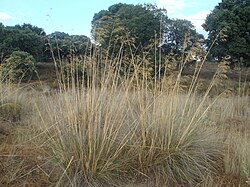| Stipeae | |
|---|---|
 | |
| Celtica gigantea | |
| Scientific classification | |
| Kingdom: | Plantae |
| Clade: | Tracheophytes |
| Clade: | Angiosperms |
| Clade: | Monocots |
| Clade: | Commelinids |
| Order: | Poales |
| Family: | Poaceae |
| Clade: | BOP clade |
| Subfamily: | Pooideae |
| Supertribe: | Stipodae |
| Tribe: | Stipeae Dumort. |
| Genera | |
28 genera, see text | |
| Synonyms [1] | |
| |
The Stipeae are a tribe of grasses within the subfamily Pooidae, with up to 600 described species. [2]